The Seat Cluster: a Starburst of Lugwork
One of my favourite parts of a bicycle frame's anatomy is what's called the "seat cluster" - the joint where the seat tube, the top tube, and the rear stays of the bicycle meet. If done nicely, the seat cluster can look like a beautiful starburst of lugwork, and that is what I love about it. On the picture above is the very classic seat cluster on the Waja trackbike I rode in Vienna earlier this summer.
A similarly classic seat cluster on the Rivendell Sam Hillborne.
And another example from an Ebisu bicycle. You can see how the individuality of the cut of the lugwork interacts with the colour of the paint to create subtle variations in form and shade. The stay caps (those narrow diagonal pieces that taper to meet the main lug) can be rounded or pointy, flat or concave, stubby or elongated.
[image via cycleczar]
They can even wrap all the way around the main seat lug, like on this Toei bicycle, so that the pointy tips meet. This is called a "wrap around seat cluster" design.
The stay caps also make for a good surface to embellish with an engraving of the manufacturer's name, like on this vintage Trek 610.
Or with hand-painted flourishes, like on this Bob Jackson.
[image via Royal H.]
They can also be carved, if so desired, like on this early Royal H. frame.
While I prefer classic seat clusters, there are also many designs that deviate into all sorts of creative directions. On this Bates B.A.R. bicycle, the seat stay caps look like sharpened pencils and meet the main lug at the bottom.
On this vintage Trek 560, the seat cluster is one big lug, and the seat stays are held by lugged sockets at the back.
And then there are seat clusters where the stays connect to the tube directly, below the lug, like on this Formigli frame. (My understanding is that both this and the method used by Trek above is done to create tighter clearances?)
A similar approach to "fastback stays" by Royal H., with the seat stays attached at the rear.
When it comes to lugwork, there is no shortage of details to get obsessed about, and the topic can provide hours of impassioned discussion to those who feel strongly about one design over another. Crazy? Maybe so, but also beautiful... like the seat cluster on my Royal H. frame that will (hopefully very soon now) emerge as a fully built bicycle.

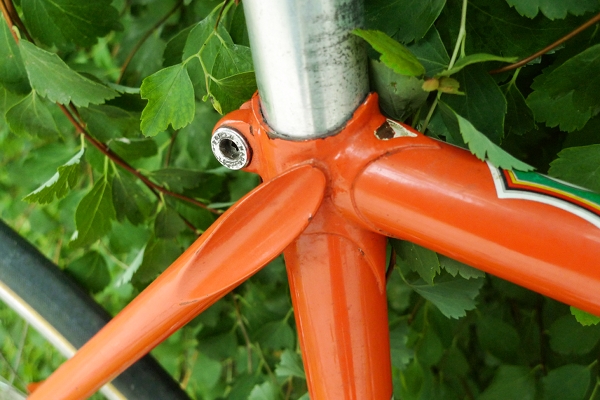

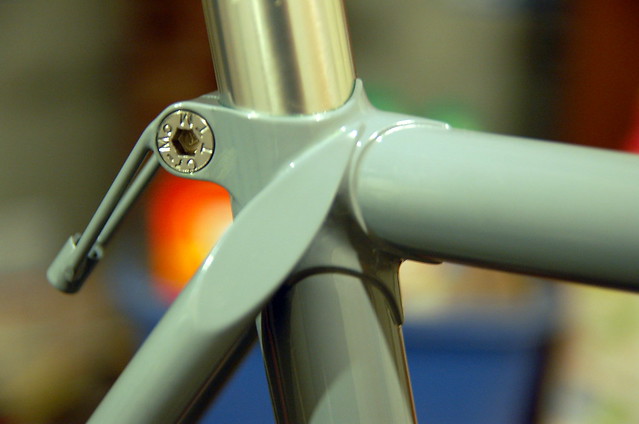

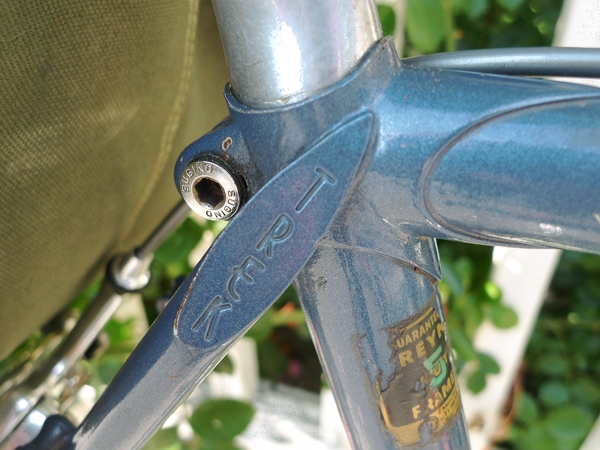

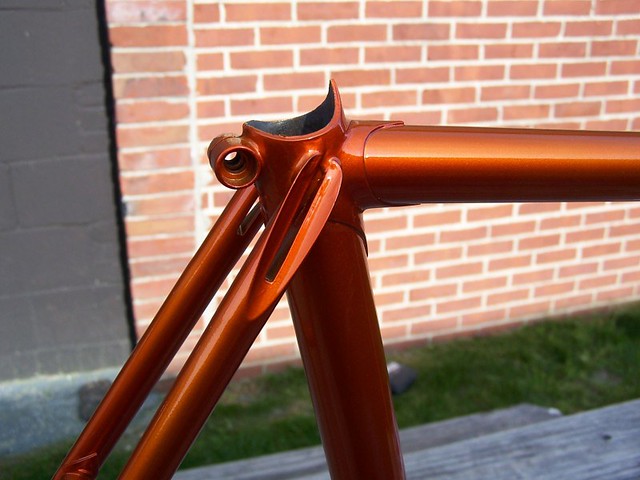

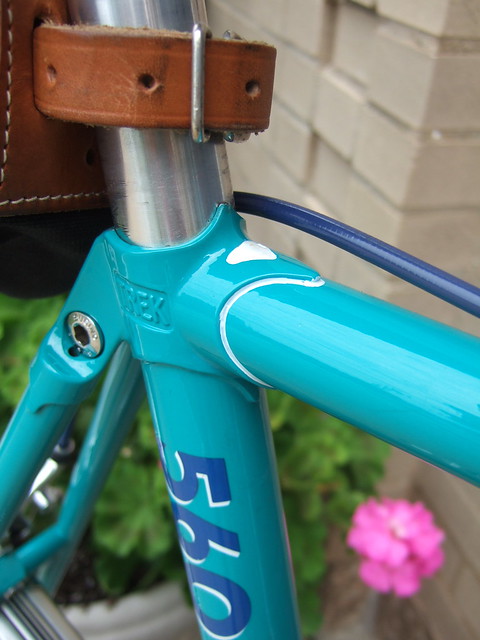
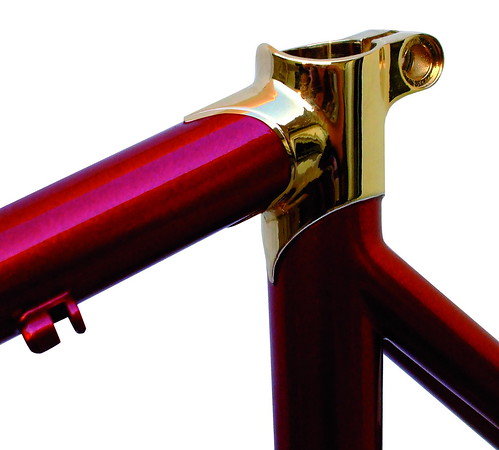


There is no benefit to reducing clearances simply for the sake of reducing clearances. There is no doubt that some builders actually do this, because they extrapolate those instances where reducing clearances DOES provide some benefit or other in a rather mindless manner.
ReplyDeleteThe fact of the matter is that "fastback" stays were developed with the idea that the seat cluster is the least elegant and clunkiest part of the bike and thus the least aesthetically attractive. They seek a more elegant solution to the problem.
In effect, its purpose is simply to disagree with your premise.
I love the seat cluster on my Raleigh, though I seem to have never taken a photo of it (must remedy soon). The design is sort of similar to the Sam Hillborne or the vintage Trek with "Trek" engraved in the stay caps, only the angled surface is much smaller. I love it, because this is one of the most prominent places where the patina of the bicycle shows through. It's hard to describe without seeing it, but it's one of those parts of the bike that you look at and just think: "wow, that's old."
ReplyDeleteThe seat stays on my wife's DL-1 are bolted on with the bolt that tightens the seat tube and of course it's a loop frame, so the top tube doesn't attach at the seat cluster, which makes for a totally different looking seat cluster.
I'm not sure I would argue that particular designs are better than others in some kind of objectively beautiful way, but more that each of them can be very elegant and beautiful in their own ways if done well. Raleigh made very simple lugs, for instance, which give a very classic, simple-but-elegant look. But I also like things such as your Royal H. frame with the more embellished lugs - they are visually interesting, and fit well with the frame.
i have never really noticed this part of my bicycle, but now i think about it and after seeing your images, i see what you mean. I may just take a little look at my bike and see what it looks like.
ReplyDeletekfg - "fastback stays", thank you! Yes, they certainly disagree with my premise... or rather I with theirs?
ReplyDeletePortlandize - If it's the Raleigh Sports, then I know the one! The seatcluster on my Raleigh DL-1 and on the Pashley are bolted too. I don't mind that on a transport bike where such a design is traditional. But on mixtes and roadbikes I got to have the full cluster!
Joe - Yes, this tends to be such a forsaken corner of the bike. But it can harbor the most beautiful lugwork!
All the above is plain lugwork compared to Hetchins, who eschewed the merely baroque and went straight to rococo: Hetchins Magnum Opus.
ReplyDeleteYes, I think pretty much everything can be described as "plain" compared to Hetchins : )
ReplyDelete".. or rather I with theirs?"
ReplyDeleteWell, let us just stipulate that a certain inverse mutuality has been achieved.
I realize that I only very weakly implied in my first comment that there is more to the issue than the mere aesthetic. There is an engineering component to the inelegant clunkiness.
What we may think of as the "traditional" way of handling the seat stays loads them in shear. The fastback loads them in compression which is more desirable.
Still, even on a BMA/6 POS you can expect the head tube to pop right off before the seat stay/seat tube joint fails. It's a place where there is a surplus of tolerance and the aesthete has a bit of room to play.
Lugs, of course, is where the aesthete can just plain go all goofy and shit.
So what exactly is "loads them in shear" vs "loads them in compression", and how does it impact the frame's stability/longevity or whatever it impacts?
ReplyDeleteWhile it's not lugged, a classic in the making seat cluster is the "GT triple triangle" setup.
ReplyDeleteI actually love a carefully crafted TIG welding job, in a way because it's easy to do in an ugly but functional way, so the beautiful ones really reflect how much care went in the bike.
Loading them in shear means that the seat stays are attached to the sides of the seat post/top tube.
ReplyDeleteImagine, if you will, that you could also assemble this by drilling a hole through the tubes, and use a bolt to attach the seat stays (a bit like the Royal H, actually). In that way, the forces applied would mainly attempt to "shear" the bolt.
Loading them in compression means that the seat post is "resting" on the seat stays, compressing the various tubes together. In that layout, one could have fairly weak welding, as it is just trying to keep the tubes together, but when they're loaded in shear, the welds (or the lug, depending on the design) are actively working to keep the bike together (a bad weld would eventually break).
What I meant about the GT triple triangle is that it's becoming a signature design that gives a bike away as a GT, even from a good distance. Good work on their part there, in terms of building a brand. I wish their bikes would be a good as they used to, though... ;-)
ReplyDelete(I hit "post" a bit too quickly before)
Pierre - Aaaah. Thank you for explaining; this makes sense.
ReplyDeleteRe the "GT triple triangle" setup - oooh, this one's not for me! (There is a lugged version of this design too, though I can't seem to find any images now.)
As far as TIG welding goes, my hands-down favourite is Mike Flanigan's (ANT Bikes) design.
Take a chunk of broom handle and push on both ends. You're compressing it. Loaded in that way a broom handle can support the metaphorical elephant (for real elephants your mileage may vary).
ReplyDeleteNow drill a 1/4" hole crosswise through one end of the broom handle and stick a dowel into it. Press on one end of the broom handle and at the other end press on the dowel. Now it will only support the load the dowel can handle before it shears off. Rather less than an elephant's worth.
A joint in pure compression will hold even if the joinery fails, because it is one piece loading directly onto another piece. The greater the load, the more it will hold.
A joint in shear fails catastrophically, as once the joinery is no longer present the load separates it. Cheap folding chairs do this with distressing regularity, since they're held together by soft rivets loaded in shear (double shear, with the rivet through a U bracket so both ends of the rivet support the load is pragmatically much like loading in compression for the case of a lawn chair, but more expensive to produce).
The joint at the seat stay/seat tube, perhaps somewhat unintuitively, is not very heavily loaded however, so as long as the joint is well formed, the issue is pragmatically irrelevant.
And how irrelevant got into my pajamas, I'll never know.
Cross posting strikes again.
ReplyDeleteThank you nonetheless, the broomhandle imagery is helpful as I lack the "abstract thought" portion of the brain!
ReplyDeleteHere is a photo of the seat cluster from my road bike.
ReplyDeletehttp://www.peter-mooney.com/gallery/pm_image105b.htm
The artist/framebuilder is Peter-Mooney who works out of the Belmont Wheelworks shop, although the bike currently lives in California.
You have a Peter Mooney bicycle?? Do you ride it? Both mine and the Co-Habitant's dream roadbike would be a Peter Money... Maybe in 5 years, when I get good enough to deserve it (and we sell off all our possessions)!
ReplyDeleteI LOVE my Legnano's seat cluster. Thanks for reminding me!
ReplyDeleteI'm not big on the GT triple triangle either, but it certainly has it's own style and signature.
ReplyDeleteI love the ANT bikes! I'd like to get one, maybe this winter? I said this last year, but had some renovation done, and I wouldn't have been able to convince my partner that a bike is a higher priority, unfortunately. :-)
Those Peter Mooney bicycles are amazing, too, wow! Although my geeky heart has a special spot for unpainted titanium bikes: the unique colour, and the future technology from the past... Feels like you could sit on one of them, and just pedal right through the sound barrier!
I cannot BELIEVE the objectification of bicycles I am seeing here! To leer at seatclusters in this DISGUSTING way just validates the oppressive cultural bias towards an unatainable and frankly perverted ideal of bicycle construction. Whats next? Why don't you just remove the seatpost altogether and take pictures of the INSIDE OF THE TUBES! I am SHOCKED!!!
ReplyDeleteSpindizzy
Spindizzy - at least I am not posting bottom bracket shots taken with hidden floor cams... yet!
ReplyDeleteOoh, great eye candy. I love the third picture the best, probably mostly because of the creamy color. I'm excited to see how your Royal H looks when it's all done!
ReplyDeleteSpindizzy- great, now we're going to see endless iterations of "Dropouts Gone Wild".
ReplyDeleteMethinks Spin doth protest too much.
Corey K
I love the cluster on the Royal H. Another favorite of mine was the fastback on Raleigh Professionals from the mid-1970's: http://www.sheldonbrown.com/retroraleighs/catalogs/1976/pages/04-76-professional.html
ReplyDeleteFunny, I just thought about this yesterday too, when I adjusted the seat. Lovely pictures.
ReplyDeleteI actually have to confess to having a keychain/bottle opener made from the last 3" of an old roadracer fork with a chrome campy dropout still attached. I am so beyond mere bike porn, I'm some velo Ted Bundy or something...
ReplyDeleteSpindizzy
Spindizzy, Puritanism is pointless. Admit it: You love "bike porn."
ReplyDeleteI thought you'd like to see the special lug on my Bob Jackson road frame:-
ReplyDeletehttp://www.flickr.com/photos/28512812@N02/2661257303/
Love this typology - thanks. Just to add to the pile: Humber cluster (from India, shot in Mozambique): http://www.flickr.com/photos/bikejuju/4688316463/
ReplyDeleteWell, I' coming in a little late, but having long been obsessed with the aesthetic challenge involved in making a non-clunky seat cluster, I thought I'd share my own attempt, as realized by that terrific artist among frame-builders, Bob Brown: http://www.bobbrowncycles.com/images/gallery/f_cluster4.jpg
ReplyDeletePierre Phaneuf said...
ReplyDeleteWhile it's not lugged, a classic in the makingb seat cluster is the "GT triple triangle" setup.
And GT was far from being the initiator of this design. It goes WAY back.
"Triple Triangle" stays are also called "Hellenic" and is an old design. It was the signature flourish of UK framebuilder Fred Hellens, who created it in 1923.
ReplyDelete